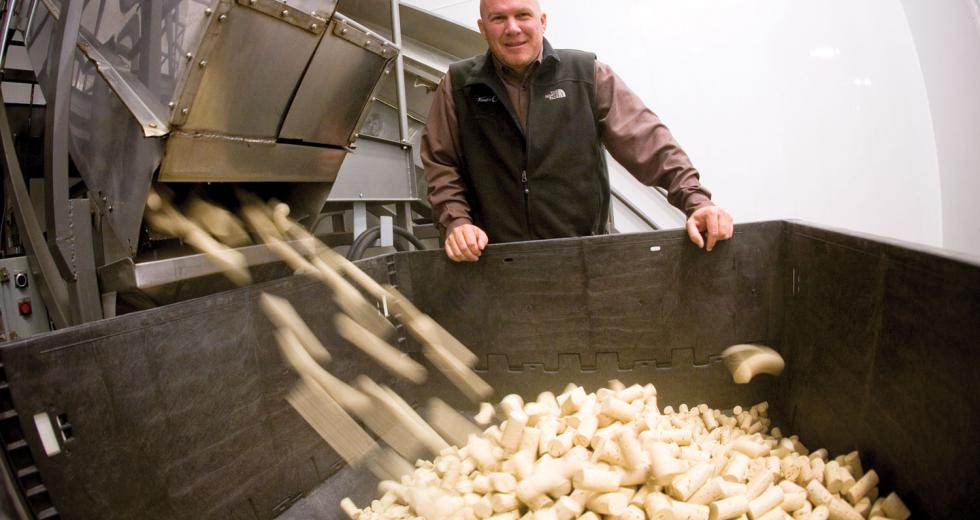Northern California manufacturers and distributors of everything from barrels to bottles to pesticides for the region’s wine industry are using the same juxtaposition to sum up the wine market: “up and down.” And for the most part, they’re using those words to describe their own businesses, some of which are growing during this rough time for wine.
Business associated with wine production contributed nearly 309,000 jobs and $39 billion to the state’s economy in 2006, according to an economic impact report by MFK Research LLC. That same year, retail and restaurant sales of wine topped $3 billion in California. This year, consumer habits have changed, and with wine being a cash flow business, it’s slowed to a trickle the past 18 months.
The numbers suggest people are still drinking wine. Sales are increasing at an annual rate of about 7 percent, says San Joaquin grape grower Steve Quashnick. But the market for bottles over $20 has declined, and the market for $100-plus bottles has plummeted. Consumers, restaurants and distributors have stopped purchasing pricey wine, causing a backup in the supply chain.
The recession has impacted the on-premise market — food and beverage establishments — with the industry expecting its weakest revenues in more than 30 years, according to a report prepared for The Wine Institute by Stonebridge Research Group LLC.
But that dip isn’t necessarily a bad thing for some businesses. In fact, a number of manufacturers and distributors associated with the regional wine market are rising to the occasion.
“Our area is producing value-priced wines, and that has created more demand in our area, to the detriment of the coastal areas selling higher priced wines,” Quashnick says, pointing to the value of varietals produced in local â?¨areas such as Lodi and Clarksburg.
Quashnick is also the central California viticulture services manager for Wilbur Ellis Co., a nationwide distributor of crop protection chemicals and plant nutrients. While agriculture is facing challenges, he says, the wine grape industry has been his “sweet spot.”
“Our sales are driven by crop production and fertilizers, [which are] annual, ongoing expenses. Anything already in the ground requires chemical care,” he says. “Sales in general have been off a little bit this year. Corn prices have dropped dramatically. The dairy people have been losing money, but the guys heavily involved in wine grapes have [increased] sales, partly due to the fact that it was a big crop year.”
Numbers aren’t available for the 2009 harvest, but experts estimate the final tally will compare to 2008. That yield brought in an estimated 3.05 million tons, down 6 percent from 2007, according to The Wine Institute.
But tonnage isn’t the sole indicator of the wine industry’s health. You also need buyers. In a September update published by Turrentine Brokerage, President Bill Turrentine called the 2009 harvest “one of the most difficult periods in our 36-year history with a deep recession and many tons of grapes getting sweet without a home.”
Wineries, especially those with high-priced brands, are trying to whittle down inventories, according to Turrentine Brokerage, and many are buying fewer grapes and supplies based on conservative sales projections. Meanwhile, a lack of vineyard expansions has caused associated businesses to struggle.
Dan Martinez owns Martinez Orchards Inc. in Winters, and he says he’s feeling the pinch. He’s been farming the sandy soils near Putah Creek since the ’50s and specializes in grapevine rootstock. He produces nearly 1.25 million plants a year, about 90 percent of which are sold to wineries on the north coast and in Napa, Sonoma and Mendocino counties. Lately, those wineries have been quiet.
“Sales have been relatively flat for the past five or six years, since the end of the last boom in planting around 2001,” Martinez says. “For us, it’s nice to have other things to farm — walnuts and prunes.”
Vineyard development has also been quiet. Planting activity has been flat in the Northern California wine region as a result of pressure on credit markets and the high cost of California land, water, labor and regulatory compliance, says Karen Ross, president of the California Association of Winegrape Growers. The combination of economic uncertainty and the availability of lower-priced foreign bulk wine to meet consumer-pricing demands has also been a factor.
“Our area is producing value-priced wines, and that has created more demand in our area, to the detriment of the coastal areas selling higher priced wines.” Steve Quashnick,central California viticulture services manager, Wilbur Ellis Co.
The barrel industry, too, has experienced a tug of war, particularly when international sales and imports are factored in. A weak dollar has made the purchase of fine French oak barrels painful for vintners, but it has also encouraged the health of Californian cooperages using domestic wood.
On average, an American oak barrel costs the consumer $300 to $400, while a comparable French variety will run upward of $1,000. In 2008, more than $131 million was spent on wine barrels in California, according to the Stonebridge report.
Still, wineries don’t make purchasing decisions on price alone. “The flavor profiles are so different between American and French oak,” says Ron Glotzer, global brand marketing director for the new Tonnellerie O cooperage and its sister companies in Benicia.
Benicia is just one of several Capital Region cities that benefits from the Northern California wine industry. In total, Benicia has about 10 wine-related companies, from cork manufacturing to display racks to distribution, says Amalia Lorentz, the city’s economic development manager. These companies employ more than 220 people and occupy more than 400,000 square feet in the Benicia Industrial Park.
“Given our central location between the Bay Area and the Sacramento Valley, adjacent to the wine country, I think this is going to be a growing sector for our local economy,” she says.
Tonnellerie O launched this year with four employees who, with the help of state-of-the-art automation, produce 10 to 12 French oak barrels a day. Just 750 barrels were produced this year. They retail between $900 and $1,200, and all of them sold, equating to nearly $1 million in revenue for the company’s first year.
Tonnellerie O’s parent company, Cork Supply Group, was distributing barrels in Australia, but the cooperages the company represented already had sales reps in the U.S. So management decided to go it alone in America, sourcing wood directly from a forest in France, where it is milled and seasoned before it ships to California.
Coopering French barrels on home turf helps the company control the process and reduce transportation costs, says group CEO James Herwatt. So far, the strategy is working.
“We projected sales would start out slow because when wineries purchase new barrels they just want to try four or six. Next year we will be close to doubling our production,” Herwatt says. “We planned for growth in 2012. Our timing was nice — by the time our volume gets bigger, the wine industry and economy should be back to normal.”
Tonnellerie O doesn’t have a sales secret. It has a seasoned sales force and loyal consumer base of veteran sister company Cork Supply USA Inc.
Founded in 1981 by a Portuguese businessman interested in distributing premium Portuguese wine corks to boutique wineries in California, Cork Supply USA Inc. launched as a distribution company in Benicia. In the ’90s, seeking more control over the supply chain, the company purchased an overseas factory and its own wood to manufacture corks. A couple of years later, the company expanded its line, selling both synthetic and natural corks, screw caps and tin and polylaminate capsules.
Last year, the 45-employee company pulled in revenues near $70 million. Nearly 30 percent of customers purchase from more than one of the company’s product lines.
Statewide, the market for corks, capsules and screw tops is valued at nearly $350 million, according to Stonebridge, and provides California workers more than $102 million in wages.
On average, Cork Supply ships more than 15 million corks a month to customers, including Kendall Jackson, Michael David Winery and Beringer Vineyards.
Even in a down economy, Herwatt says he expects business on barrels and corks to remain strong in 2010, and Glotzer says many other businesses associated with the wine industry will likely remain stable as well.
“At this point you just have to decide whether to bottle it or not,” Glotzer says. “You could choose to let the fruit go. Or you can sell it, which I guess some people are. But likely you are going to put it in barrels, and you have to have bottles, and you have to put something on the top of your bottles. The industry is already made.”
Recommended For You

Wine Winner
How Dr. Grover Lee went from the pharmacy to the vineyard
Imagine you’re a successful businessman, but what you really want to be is a professional baseball player. You’re so sure of yourself that you begin spending nights and weekends studying and training as if Major League Baseball will soon be calling. And then they actually do, and at your first at-bat, you clear the bases.
That’s pretty much how things happened when Granite Bay pharmacist Dr. Grover Lee decided to become an award-winning winemaker.

The New Wine Country
Opportunity abounds for California varietals
Let’s say you’re in a glitzy Beijing restaurant. Your waiter uncorks a $300 bottle of Cabernet Sauvignon. He pours you a glass and you sip it, savor it, let it breathe. But around the table, everyone else gulps theirs down one swallow, like a shot, yelling “Gan bei!”
Welcome to wine culture in China.



